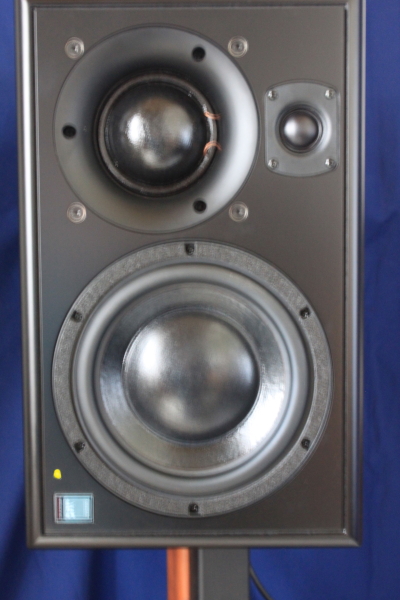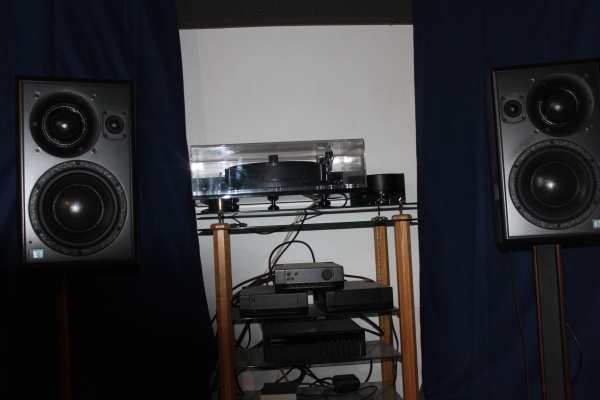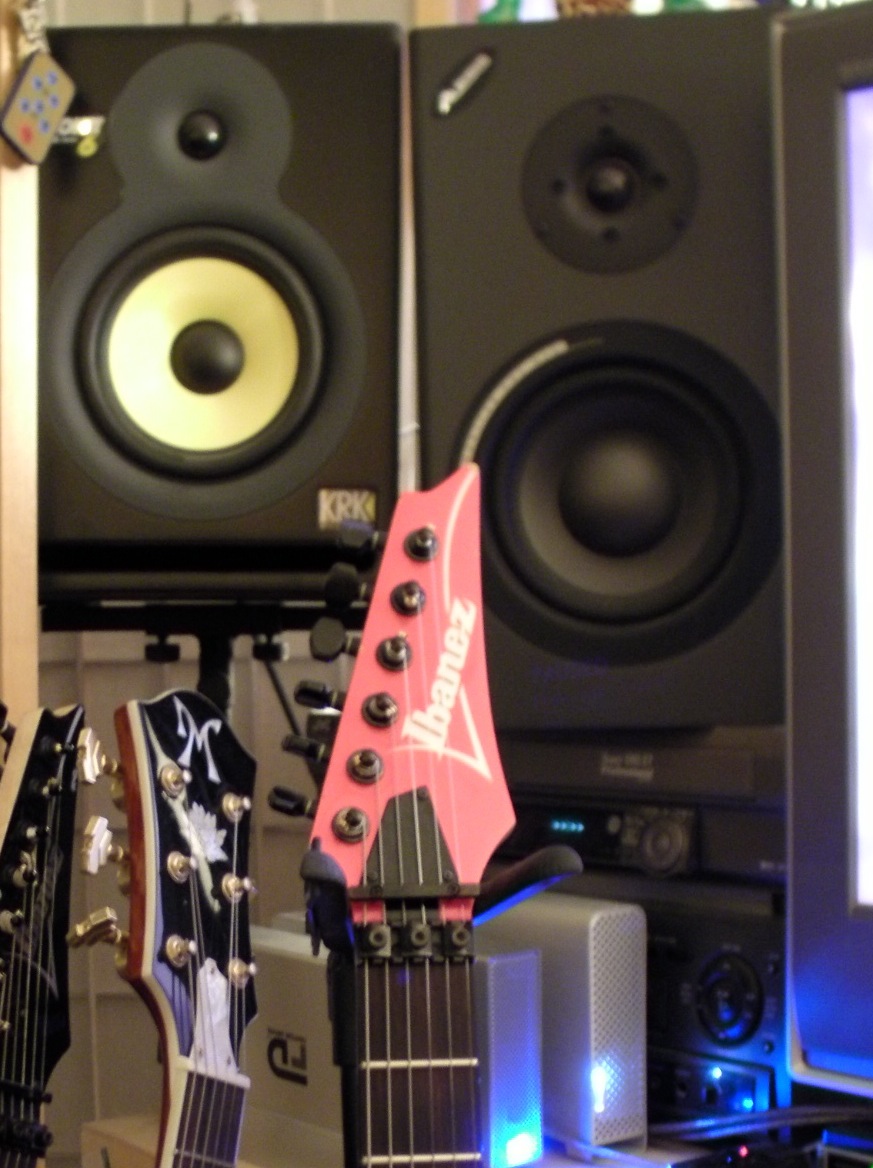Printable Version of Topic
Click here to view this topic in its original format
GMC Forum _ Recording _ Monitors And Room Placement
Posted by: tonymiro Mar 9 2011, 02:03 PM
Quite a few members either have or are setting up home studios so it may be useful to say something about monitors.
One of the major purposes of mastering is to offer an objective and unbiased opinion of a mix. There´s a popular saying used in mastering, ´If you can´t hear it properly, you can´t fix it´. This of course points to how important monitoring and room acoustics are in mastering.
Most mastering engineers will place more emphasis on ensuring that they have the highest quality playback system that they can and will spend in excess of 10k$ on this alone. This includes the pc interface to a DAC, the monitors and any power amps necessary, monitor stands and appropriate room treatment. I´m going to focus mainly on the monitors and placement here.
Most MEs use mid or far field 3 way monitors. Here´s a picture of ours (they´re ATC SCM Pro monitors):
3 way here simply refers to the number of speakers in the monitor, a bass and mid driver and a high frequency tweeter. We use 3 way speakers rather than 2 way as it means that we have speakers dedicated to both bass and mid range. Most recording/mixing stdio monitors are 2 way and there a single speaker has to reproduce the bass and the mid range. This separation in to 3 speakers also means that the monitors have two cross over filters. The cross over is the point where the audio signal is sent to a particular speaker. In mastering grade 3 way monitors the cross overs are carefully chosen to ensure that the reverberant sound (the sound that disperses backwards and to the sides of the speaker) is consistent with the direct sound (the sound that travels directly to you in your listening position). In an appropriate system you should here the direct sound first and the signal should be linear across its frequency range and with no significant amplitude troughs off axis. If these are not consistent then the monitor can not produce accurate low frequency detail and will introduce phase and timing errors.
As there are three speakers and two cross overs each monitor here is tri-amped. That means we have an individual power amp feeding each speaker (6 amps in total). This allows us to ensure that the amps power output is suitable for the particular speaker and also ensure that each is dedicated to driving just one speaker. Amplifiers connect to the speakers via balanced XLR leads and connections to reduce hum and noise.
3 way also means that the on-axis position here is in line with the axis of the mid range speaker. In a 2 way system the on-axis position is usually the centre of the tweeter. The on-axis position should be level with your ears when you are seated in your normal listening position. To achieve this we have our monitors located on speaker stands:
Stands are often made from cast iron or steel and are filled with sand or lead shot. This is so that they have a very high mass, very rigid and do not ring and it helps ensure that the monitors do not move at all, particularly when reproducing bass heavy material at high levels.
Monitors suitable for mastering are usually large and heavy. (ours weight 70lb each) This is partly due to the physical size of a bass driver - they are rarely less than 6 inches in diameter and in some far field systems may be as large as 10-12 inches in diameter - and partly due to the construction required to produce an inert, rigid speaker enclosure. A large bass driver is required so that low frequency can be accurately reproduced linearly and without distortion as far down to 20Hz as possible. Mastering grade monitors usually extend down to around 30 Hz without the need for a sub woofer: a standard mixing grade monitor often starts to roll off noticeably from between 60-100 Hz. Whilst a sub woofer can be used many MEs prefer not to as they can introduce other issues - particularly timing and phase - into the sound reproduction.
Normally mastering monitors are mid or far field whilst mixing monitors are near field. near field studios are designed to be placed close to a rear wall and they use early reflections from that wall to increase the level of the perceived bass. Most mixing engineers sit very close to their speakers, hence near field, and the assumption is that any timing and dispersion issue due to poorly controlled and produced reflections and reverberation will not be noticeable. Mastering engineers tend to sit some distance away from their monitors because the monitors are positioned in much the same way as a traditional hi-fi stereo in order to produce an accurate stereo field, left to right and front to back. Positioning here means that a mastering grade monitor does not rely on the rear wall to reproduce bass but must produce the bass itself and account for reverberation as already mentioned. Actual positions for mastering monitors differ by model but they are often placed so that they stand 1 meter away from the nearest side wall, at least 2 from the back wall and with 1.5-2 meters between them: if the position is bass light the monitors may be moved closer to the back wall. Monitors are usually toed in slightly so that they are angled slightly towards the listening position. The listening position is usually about 1/3rd the way in to the room close to the first reflection point.
Placement clearly means that a mastering studio is quite large, often at least 10 feet wide and more than 18 feet long. Rooms are usually rectangular but not square. Ours is a rectangle but acoustic treatment has actually resulted in a room that is more like an irregular hexagon/boat shape because of the number and placement of bass traps.
Many mix studio sit their monitors on the meter bridge of the desk/console so that they are close to the mix engineer and to save space. A major draw back of such an arrangement is comb filtering introduced by unwanted reflections from the console and desk top. In addition, most mixing studio have a large amount of hardware close to the monitors and mix engineer and again reflections from these can lead to comb filtering. In a mastering studio the speakers are normally set up so that they stand in free space and so that there is nothing, or very little, between them and the mastering engineer.
A final brief comment on room treatment. A mastering studio is not the same as a recording or mixing studio and the treatment required differs. Every studio is different but as a generalisation most mastering studios will have been acoustically treated to produce sound as accurately as possible across the 20-20kHz range. Most will have a lot of specialised bass trapping, particularly behind and/or to the side. The material used for bass trapping is normally sheets of very dense rock wool (our bass traps have several layers of rock wool to a depth of 6 inches - some of them are behind the dark blue cover). As mentioned in a different thread by Todd acoustic foam does not have suitable properties to work as a bass trap.
Posted by: Mudbone Mar 9 2011, 02:55 PM
Very informative, thanks for posting ![]()
Posted by: Gilmore Mar 9 2011, 04:42 PM
Good information here. ![]()
Why does Auralex make their basstraps out of foam, since so many say it does not work well or at all?
Posted by: tonymiro Mar 9 2011, 05:58 PM
Why does Auralex make their basstraps out of foam, since so many say it does not work well or at all?
They will trap some of the bass but not enough for mastering. Depending on your mix environment and monitors it may be ok, certainly better than nothing but not ideal.
Posted by: Ivan Milenkovic Mar 9 2011, 10:59 PM
Just a thing I need for my future upgrade. Thank you for writing this! ![]()
Posted by: Jerry Arcidiacono Mar 9 2011, 11:12 PM
I have to say that we're pretty lucky to have your experience available here at GMC! Thank you for posting all these info. I'm upgrading my studio gear and I'm finding them very helpful!
Posted by: Todd Simpson Mar 10 2011, 01:30 AM
Another great post from Tony! I wanted to mention using more than one set of monitors again as well. I use a set of KRK ROKIT 6's and a pair of Alesis Control 1's. They sound way different. Going back and forth between them really does help my mixes "travel" better. Mixing to one set of speakers can create problems in a mix. Which is why, as tony knows, studios will often have 3 pairs at least. 1 big pair usually built in to the wall called the "Mains", 1 medium pair of "Nearfields"(like my KRK's) and a smaller set of NearFields that are really pretty crappy and have no bass at all just to see what the mix sounds like through crappy speakers. For years, AURATONE made a sort of industry standard craptastic little speaker. 4 inch driver, no tweeter. Awful. But if your mix sounded remotely decent through them, you were heading in the right direction.
One thing that REALLY helped me was the addition of a 15 inch subwoofer so I could hear what was happening in the low range beneath where my monitors cut off. This is a HUGE problem with nearly every home studio I've ever seen. Mixing frequencies that you can't hear leads to tremendous problems in a mix. So if your speakers roll off around 60hz, and you take your mix someplace with a sub that goes down to 30 or below, all of the sudden your mix sounds BOOMY and dull. Headphones can help, but are seldom accurate. A sub is a great addition to anyone recording at home. 
Powered by Invision Power Board (http://www.invisionboard.com)
© Invision Power Services (http://www.invisionpower.com)
